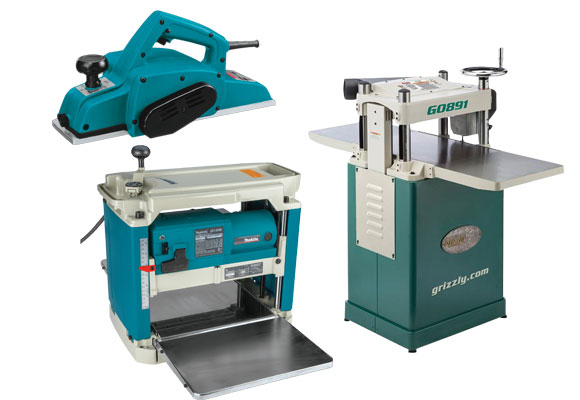
Types of Electric Planers Explained
Woodworking is a timeless craft that requires precision, skill, and the right tools. Among the various tools used by woodworkers, electric planers have emerged as indispensable companions in achieving smooth and precise surfaces. These versatile machines make it easier to shape and smooth wood with efficiency and accuracy. The way electric planers are built is quite similar to manual planers, the blade of an electric planer rotates thanks to the engine that powers it. Generally speaking, electric planers can be divided into three types: handheld/portable electric planers, benchtop electric planers, and stationary electric planers. Today, we will provide an overview of the different types available, and guide you towards making informed choices when it comes to selecting the right planer.
Portable Handheld Electric Planers

(Image Source: makitatools.com)
Portable handheld planers are ideal for trimming and leveling surfaces of wooden workpieces. They work similarly to manual planers by removing small amounts of wood from the surface. A portable planer consists of a cutting head mounted on a planer base, equipped with two or three spinning blades that replace the static blade in the manual one. A contoured handle provides precise control over the tool. The knob on the planer is a switch that is used to set the depth of the cut, allowing you to control the amount of material removed. There are two types of portable handheld planers available on the market: corded and cordless. Cordless hand planers operate using a battery-powered engine, eliminating the need for a constant power source. Therefore, they are perfect for situations where there is no electrical power source available in the workshop or furniture cannot be relocated.
Benchtop Electric Planers

(Image Source: makitatools.com)
A benchtop electrical planer is a heavy-duty tool that is designed to cut large pieces of wood with high precision. Unlike a portable planer, a benchtop planer is not suitable for small, detailed woodworking jobs. With high-speed blades and adjustable cutting height, this heavy-duty electric planer can quickly and uniformly trim rough lumber to your desired specifications. Thus, with a benchtop electric planer, you don’t need to purchase pre-cut lumber that may not match your exact requirements. Simply feed the workpiece through your benchtop planer and let it do the job, while you hold the workpiece in place.
Stationary Planers

(Image Source: grizzly.com)
Stationary planers are commonly used for large-scale projects in professional woodworking shops due to their large size and fixed position. They are particularly effective for precise thicknesses required in industrial production such as furniture construction and cabinetry.
Blade Selection
When selecting planer blades, you have a choice between high-speed steel (HSS) blades and tungsten carbide blades. HSS blades are designed for softwoods and can be sharpened frequently. Tungsten carbide planer blades, however, are stronger and are ideal for working with hardwoods and synthetic woods. Most carbide planer blades are double-sided for extended service life. When they are worn and broken, it is advisable to replace them directly.
Konetool is a reliable manufacturer and supplier of planer blades, both HSS and carbide. Planer blades have been our featured products since the establishment of Konetool. Our full CNC production line and standard quality control lab ensure our planer blades’ consistent and premium quality. If you are looking for the right B2B supplier, contact us today! Our salespeople are ready to help you with your inquiry.
Factors to Consider When Choosing an Electric Planer
In general, there are several factors to consider before purchasing an electric planer.
- Purpose
Why do you need an electric planer? Are you planning to use it for occasional work or professional work? Portable handheld electric planers are designed for small projects, while benchtop planers are suitable for dealing with large-sized lumber. So, first thing first, make sure of the purpose of your purchase.
- Budget
The price tag of handheld electric planers usually ranges from 100$ to 200$. Benchtop planers cost you about 200$ to 1000$. If you plan to buy a stationary planer, it should be a serious investment because it costs thousands! So, budget is another crucial factor to consider.
- Size
Do you have enough space for your new electric planer? For a small-sized handheld electric planer with 3-1/4 in. in width, space is not a big problem. However, benchtop or heavy-duty planers are evaluated based on their maximum cutting width and height. In addition, larger models have a minimum board width that they can accommodate, which should be taken into consideration.
- Blade
Portable planers can be equipped with one or two blades, while benchtop planers can use three or more blades. Besides, HSS and tungsten carbide planer blades are available on the market. Carbide-tipped or solid carbide planer blades are more expensive than HSS blades but are more durable.
- Speed
Electric planers with a high rotation per minute (RPM) can result in a cleaner and smoother finish.